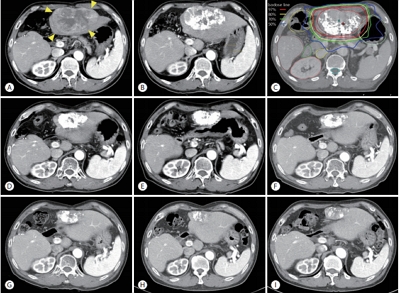Search
- Page Path
- HOME > Search
Case Report
- Combined Transarterial Chemoembolization and External Beam Radiotherapy in a Patient with Recurrent Huge Hepatocellular Carcinoma after Hepatic Resection
- Jesang Yu, Jinhong Jung, Sang Min Yoon
- J Liver Cancer. 2020;20(1):90-97. Published online March 31, 2020
- DOI: https://doi.org/10.17998/jlc.20.1.90

- 3,381 Views
- 79 Downloads
-
 Abstract
Abstract
 PDF
PDF - The optimal treatment strategy for unresectable huge hepatocellular carcinoma (HCC) is yet to be established. Non-surgical monotherapy demonstrated insufficient oncologic outcomes in previously reported studies. To improve the clinical outcomes of unresectable huge HCC, combined locoregional treatments can be considered in selected cases. Here, we report a case of 58-year-old male patient who was treated with combined transarterial chemoembolization (TACE) and external beam radiotherapy for recurrent HCC after a previous hepatic resection. After combined TACE and radiotherapy for the intrahepatic lesion, two metastases were diagnosed in the pelvic bones and lung; each lesion was successfully treated with salvage radiotherapy. During the long-term follow-up period (around 8 years 7 months after combined TACE and radiotherapy for the recurrent huge HCC), no definite viable tumors were observed in any of the treated liver, bone, and lung lesions.

Review Article
- Is the treatment needed for massive hepatocellular carcinoma? Pros
- Si Hyun Bae
- Journal of the Korean Liver Cancer Study Group. 2009;9(1):7-12. Published online June 30, 2009
- 483 Views
- 0 Download
-
 Abstract
Abstract
 PDF
PDF - Although advanced HCCs larger than 10 cm in diameter are still often seen, the survival benefit and safety of the treatments for patients with huge hepatocellular carcinoma is uncertain. With conservative management, median survival in patients whose huge tumor invades the main portal vein is approximately 3 months. Surgical resection is the only way to cure the disease for patients with big tumours. However, huge tumors frequently present with poor liver reserve, vascular invasion and intrahepatic dissemination, all the factors limit the resectability of huge HCC. Transcatheter arterial chemoembolization (TACE) is a main palliative treatment for unresectable HCC. For unresectable HCC larger than 10 cm in diameter, TACE is the only treatment option. Responses to transarterial chemotherapy are infrequent and there exists considerable skepticism as to the value of the therapy because it could give rise to excessive liver damage for huge HCCs. The recent study suggests that patients with HCC larger than 10 cm in diameter are not suitable candidates for TACE treatment because of a high mortality rate due to serious side effects. Whether TACE is beneficial or not for this type of patient deserves further study. Several investigators have sought to delineate potential benefits of various therapies, although the lack of consensus regarding standards of care in advanced HCC. There are only a limited number of reports to date focusing on TACE for patients with HCC larger than 10 cm in diameter. Herein, we conducted this retrospective, case– control study to elucidate the outcome of multimodal therapies based on TACE for patients with huge unresectable HCC and determine the factors that are independently associated with the survival.


 E-submission
E-submission THE KOREAN LIVER CANCER ASSOCIATION
THE KOREAN LIVER CANCER ASSOCIATION
 First
First Prev
Prev



 Follow JLC on Twitter
Follow JLC on Twitter